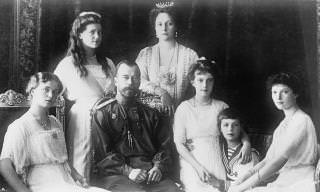



Why Guilt Can Be Much More Damaging Than You Think...
There's much about guilt that many of us don't know, and some of the facts relating to it are very surprising. Here are 10 surprising facts about guilt.
 5:02
5:02
Where Did The R in Mrs. Come From?
Learn a little language history and also, where did the R in Mrs. Come from?

How Columbus's Life Was Saved By the Moon
Celebrate Christopher Columbus day on October 11th with 5 facts you didn't know about him.

Step by Step: Learn 36 Interesting Facts About Walking
What are the benefits of speed walking and how long would it take to walk around the planet? Learn this and much more now!

I Bet You Didn't Have a Clue About These Human Body Facts!
The human body is the most complex machine known to mankind, but I bet you don't know these 10 amazing facts about it...

This Is the Most Simple and Natural Way To Ease Insomnia
Weighted blankets are knwon for their soothing effects, and a new study confirms they may even be the tool to cure insomnia

These 6 Mysterious Objects Can't Be Explained by Anyone
Archaeology is a very rewarding discipline, but there are some mysteries that never get solved. Take these 6 ancient objects. What they are is anyone's guess!

These Photos of 1920s Criminals are Fascinating
Through archival snippets, we uncover tales of deception, ambition, and survival, painting a vivid tableau of a bygone time where lawlessness wove its complex tapestry.

Louis Armstrong Said it Best, Didn't He...?
This amazing song can really open your eyes to nature's beauty, and the beauty we make for ourselves.

Say Cheers & Raise Your Drinks to These 15 Terrific Toasts
I have been known to offer a few toasts myself when the occasion has grabbed me, but these are 15 of the very best toasts I have ever heard.

These Famous Characters Are Based On Real People!
Did you know that certain characters draw heavily on real-life people? Here are 10 iconic characters that were based on people that really existed.
 2:21
2:21
This Ancient Cabinet is FULL of Surprises...
One of the finest achievements of European furniture making!

The Fascinating Ways Our Fruits and Veggies Are Grown...
Here are some of the amazing the ways that fruits and veggies grow that may be new to you!

These Native American Achievements Are Truly Outstanding!
Read all about ten of the greatest achievements that the Native Americans made before the arrival of Europeans

Men vs. Women: What Does the Science Say?
10 studies and articles that dive into the real differences between the sexes, asking the meaningful questions and looking at real data.

We Bet You Never Knew the Origins of These Common Idioms!
We bet you use the following 8 common idioms all the time, but have you ever stopped to take the time to think about where they came from?

Beware of Ordering These (Potentially) Fake Foods
There are certain items on a restaurant's menu that should be considered with caution, and this is because they tend to be faked. Learn more here.
 11:27
11:27
Looking at a 100 Years of High School Fashions...
Here's what high schoolers wore each decade of the 20th century.

English Really Needs a Translation for These Foreign Words
With so many words in the English vocabulary, we still as yet have to come up with a word to describe how we'd feel in these instances.

These 3 Breakthroughs Are Making Historians Jump for Joy!
Learn about some of the most fascinating findings that archaeologists and historians have recently uncovered. Get ready to be amazed!

The Secrets Behind 5 Famous and Beloved Magic Tricks!
Get to know the secrets behind well-known magic tricks with these 6 fascinating explanations.

Travel History With These Amazing Photos of Yesteryear
Amazing photos reveal 150 years of history.

10 Emmy-Winning Netflix Shows You Don't Wanna Miss...
if you're in need of a binge-worthy series and haven't explored these recommendations yet, prepare to be captivated.

21 Tips to Make Your Golden Years the Time of Your Life
Many seniors will offer a different piece of advice on life. This collection of tips will allow you to live the most wondrous golden years imaginable.

Listen to the Enchanting Notes of the World's Oldest Songs
In this article, we will be talking about the oldest known pieces of music ever found.

20th Century: The MOST Popular Breakfast of Every Decade
Breakfast shape-shifted quite a bit during the 20th century. Discover the most popular breakfast delicacy of every decade in this article

The Incredible Story of a Boy Surviving 49 Days at Sea!
This Indonesian teenager managed to survive almost 50 days at sea while adrift in a floating wooden hut. Learn all about his amazing story here.

10 World War I Inventions We Still Use Every Day
From trench coats, to pilates and blood banks, all of these 10 things we think of as very modern were actually conceived during WWI.

Check Out These Rare and Fascinating Antonyms!
Here are a few rare but fascinating antonyms we wish people used more often.

Archeologists Are Dumbfounded By These Discoveries
These archelogical sites have been proven to be difficult to explain.
 4:50
4:50
This Project Gets Thousands of Disabled Children Mobile Again
This project may give thousands of physically impaired children the ability to move around again.

Collection: The Greatest Moments in History
A collection of fascinating, sometimes controversial and surprising stories from the annals of history. Explore and learn about the fascinating past of humanity and some of its most outstanding figures.

13 Books That Will Make Your Time Fly
These times of social distancing are perfect for catching up on your reading. Check out this list of 13 must reads to get started.

10 of the Fiercest Ancient Celtic Gods and Goddesses
Here we look at the most influential ancient gods and goddesses from the ancient Celtic pantheon.

The Dark and Fascinating History of the Romanov Family
For more than three hundred years, the Romanov family had absolute power over Russia, this is their fascinating story.

Things You Don’t Know About History’s Famous Artifacts
Wow, history really is an endless treasure trove of knowledge!
 3:00
3:00
What is HAMAS? The Terror Organization Explained
What IS Hamas? What are its intentions, and how did it get started?

14 Creepy Facts That Will Send Shivers Down Your Spine
These 14 surprising facts about the world may definitely send shivers down your spine, but they are still important to know and recognize!

When it Comes to Inventive Solutions, These Guys Are Top!
We all face different issues every day and our solutions to these minor problems vary widely...

You’ll Love Learning New Things With These Awesome Charts
It's time for a brand new collection of fascinating charts and guides.
 5:06
5:06
Watch Andrea Bocelli and His Daughter Perform "Hallelujah"
Watch the legendary singer Andrea Bocelli perform a beautiful rendition of the famous song "Hallelujah" with his little daughter.

Witness the Might of the World's Greatest Empires
The world's greatest civilizations and empires had a marked effect on history and shaped the world as we know it today. Watch these informative videos.

Celebrities of the Past In the Most Fascinating Photos
These rare images capture celebrities, royalty and scientists as you've never seen them before. Be sure to check out this extended picture gallery.

20 Maps and Charts That Explain the World in Unique Ways
Time for some more fascinating and informative maps that show interesting aspects of our planet.

Incredible Maps: The World of Second Languages!
We all know the main languages, but these maps of second languages really surprised me!

A Nostalgic Look Back at Prices in the Past (14 Pics)
Travel back to the time when things cost just a few cents.
 46:36
46:36
50 Years On, Looking Back at the Great Train Robbery
The Great Train Robbery was one of the greatest heists in British history. This documentary could be the last chance to find out the answers everyone wants...


